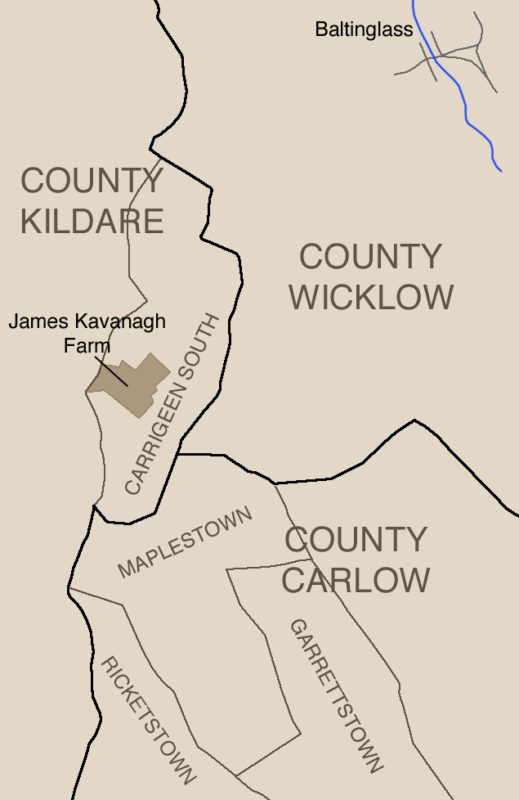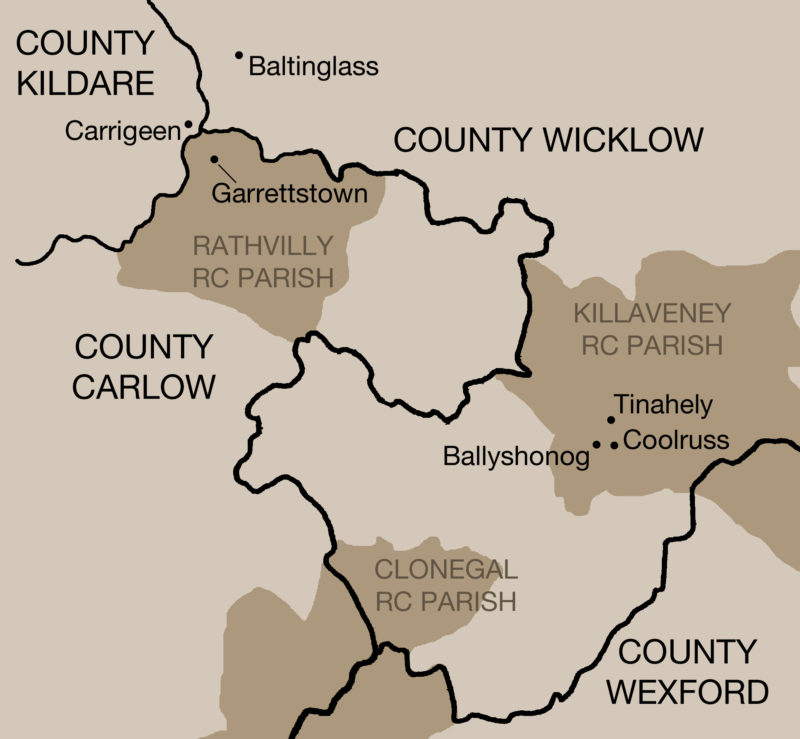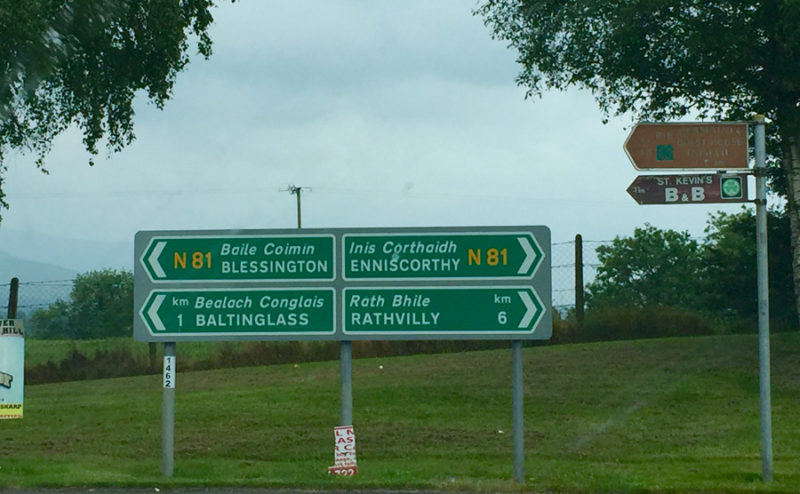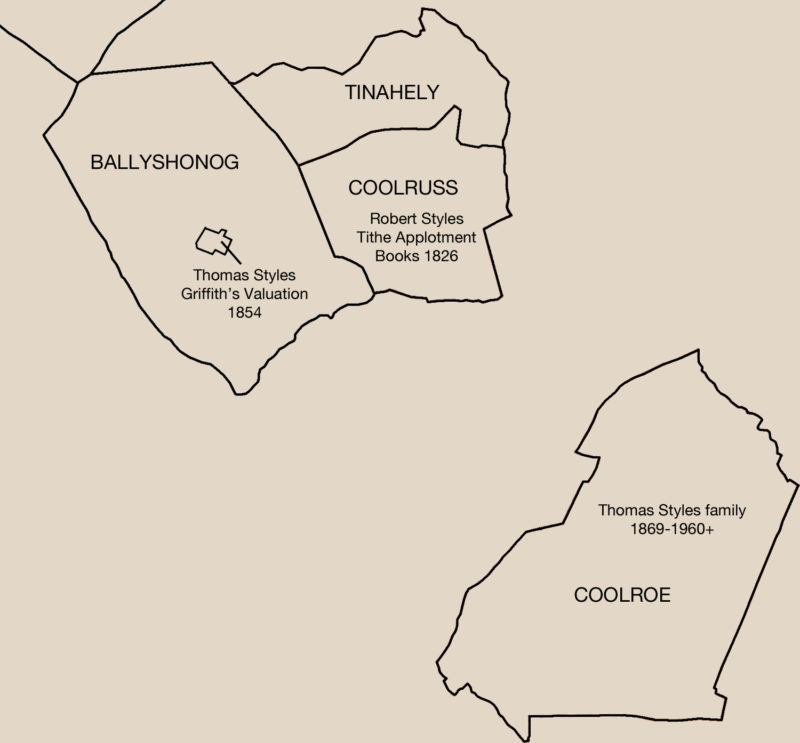I visited the town of Baltinglass in County Wicklow Ireland this past June. My great-grandmother Margaret Styles was born here in 1876 to Edward Styles, a harness-maker, and Margaret Kavanagh, a farmer’s daughter from Carrigeen, just over the border in County Kildare. Edward Styles, however, was not from Baltinglass. When we were talking with the people in the town, everyone was familiar with the Kavanaghs of Carrigeen, but no one had heard of the Styles. It does make sense because our family was the only Styles family living in the town when they emigrated in 1888. I believe Edward Styles was born in Ballyshonog, just outside of Tinahely in County Wicklow, to Robert Styles and Anne Byrne. We explained this to a local young man and he nodded, “Ahh, so that’s why we don’t know the Styles!”
The Styles first appeared in the Baltinglass area in 1834 in Ricketstown, County Carlow, the townland just south of Carrigeen. In 1835, a Richard Styles of nearby Garrettstown, County Carlow converted to Roman Catholicism. Several more Styles marriages and baptisms followed until 1848, when the Styles appeared in records in Carrigeen, County Kildare. I wondered what brought the Styles to Ricketstown and Garrettstown, so I did a little research on the area. Newspapers reporting on the Tithe War of the time gave a fascinating account of local events. The Tithe War comprised a series of reactions, mostly non-violent, by a population that was mostly Roman Catholic, against mandatory tithes to the Church of Ireland.
BARONY OF RATHVILLY—Mobs are daily patrolling the country BLOWING HORNS, and threatening with death any person who attempts to serve a law process. That part of the country is completely under the dominion of those lawless ruffians…
ATTACK ON THE REV. MR. WHITTY.—…Mr. Whitty, junior, accompanied by a person in his employment, proceeded to the lands of Garretstown, in the barony of Rathvilly, to serve those with latitats who were indebted to him for tithes. From the systematic manner in which the peasantry are now collected together by signals and horn blowing, a great number of persons from various parts of the barony were immediately on the spot, shouting, and flourishing every description of weapon, and threatening to murder Mr. Whitty
The Great Britain House of Commons Papers had a Poor Inquiry for Ireland appendix to its 1836 volumes with “Baronial Examinations relative to food, cottages and cabins, clothing and furniture, pawnbroking and savings’ banks, drinking.” It had this to say about the Barony of Rathvilly:
Q: Of what class of persons, generally, are the landlords of cottages or cabins? A: The poorest farmers
Q: What is the ordinary diet, and condition with respect to clothing, of the labouring classes? A: Potatoes; only occasionally a little milk can be procured; their clothing is of the worst description, not affording protection from cold or rain
Q: Of what description of buildings are those cabins, and how furnished? A: Mud or sod walls, seldom thatched so as to keep out the rain; a box, a few boards hung against the wall for a dresser; two or three stools, a pot, a table. A straw bed on the ground, one, or at most two blankets, and a plentiful supply of smoke when the materials can be procured to raise it
They make it sound like such a great place though! All kidding aside, if Edward Styles was still alive he would have chuckled approvingly at the description. From everything I know about the family, a “lawless ruffian” is exactly how he would have wanted to be remembered.

I took note of the couple William Styles and Catherine Brennan in the above parish records. Our ancestor Edward Styles was the sponsor at the baptism of their child Robert in 1844. William and Catherine were living in Carrigeen in 1848 when their children Margaret and Eliza Styles were baptized. Anne Kavanagh, sponsor at the baptism of Eliza Styles, was my great-great grandmother Margaret Kavanagh’s oldest sister. Both William and Edward Styles named their oldest two children Robert and Anne. This is not proof of anything, but it was very common to name the first son after the father’s father. I believe they were brothers, possibly cousins, but they were definitely related. William Styles and Catherine Brennan were married in the Roman Catholic parish of Clonegal on 11 Feb 1839 [record image]. This parish covers a tri-county area where Counties Wicklow, Wexford and Carlow meet. That gave me some idea of where the Styles had come from.
William Styles and Catherine Brennan immigrated to America during an Gorta Mór, the Great Hunger, settling in Plattsburgh, New York. They had a total of 13 children, including Judge John William Stiles of Menominee, Michigan. He was obviously not a lawless ruffian.
When I searched through early baptism and marriage records for County Wicklow and Wexford, I saw there were several Styles families near the Roman Catholic Parish of Clonegal, and also living in the townlands surrounding Tinahely, County Wicklow in the early 1800s. For the past 3-4 years, I have been compiling baptism and marriage records in both counties from multiple sources. All of my extracted records are here in more detail: Styles baptisms and marriages in Counties Wicklow and Wexford. There were Styles families in both Roman Catholic and Church of Ireland parish records. The name Styles is English, but exactly when the Styles first came to Ireland is hard to say. Edward MacLysaght’s book, The Surnames of Ireland, has an entry for Styles that states, “Styles, An English locative name found in Co. Wexford.”

Edward Styles, my great-great grandfather, was born sometime between 1821 and 1828 according to the two records I found where he gave his own age. An Edward Styles was born in 1822 to Robert Styles and Anne Byrne, in the townland of Ballyshonog in the Civil Parish of Kilcommon in County Wicklow, and baptized at Killaveney Roman Catholic Church (27 Jan 1822, address Ballyshonog). There are two other children for Robert and Anne recorded in the baptism records for Killaveney Roman Catholic parish: Mary (8 Mar 1814, address Clone) and James (22 Sep 1816, address Tinahely). There was another Edward Styles, born to Robert Styles and Catherine Byrne (15 Aug 1823, address Ballyshonog). This might actually be my great-grandfather Edward, with the name Anne mistakenly recorded as Catherine. Embedded below is a Google Street View photo, looking east from Ballyshonog, County Wicklow.
The Tithe Applotment Books, a tax basis taken between 1823-1837, list in 1826 a Robert Styles in Coolruss (also spelled Coolross) directly next to Ballyshonog [link to image at Family Search]. Interestingly, the townland of Coolruss by Tinahely did not appear in as an address of residence in local Roman Catholic Parish records until the 1850s. The same residents of Coolruss in the Tithe Applotment books gave their address as Ballyshonog in records of marriages and baptisms at Killaveney Roman Catholic Parish.
The area of County Wicklow near Tinahely and Clonegal was part of the Earl Fitzwilliam’s Coollattin Estate in the 1800s. During my trip to Ireland, I visited the National Library of Ireland in Dublin, where I looked through the microfilm, “Account of residents and occupiers of land on the estate of the Earl FitzWilliam (except Rathdrum, Wicklow, Newcastle and Jigginstown) taken in the years, 1827, 1839, 1848, 1850, 1860, 1868.” Residents for each townland were listed along with ages, number of male and female children, occupation, and size of land holding. In the townland of Coolruss, there is a Widow Styles age 41, listed with four sons and three daughters. So Robert Styles must have died around 1826-27. In addition, the record proves that Robert Styles and Anne Byrne did have more children who do not appear in surviving baptism records.
No Styles were in the Fitzwilliam residents lists for Coolruss or Ballyshonog for the year 1839. However, I noticed a curious note on the 1827 list of residents for Ballyshonog (spelled Ballicionogue on these lists).
Until the last year, which unfortunately passed away un-productive one in this neighbourhoods, the common poor people generally supported themselves, and rarely paid their rents by their labour with [?], but in consequence of the failure in the crops last year they are now out of provisions and in arrears of rent. Abm Bates
Crop failures and the death of Robert Styles, the head of the family, would definitely explain why the Styles moved away. By the 1840s, the only Styles in Ballyshonog was Thomas Styles, who was a harness-maker, just like my great-great grandfather Edward Styles. Thomas married Mary Byrne in 1844. The couple had five sons, all born in Ballyshonog and baptized at the Killaveney Roman Catholic Church: Robert (9 Aug 1845), Thomas (6 Feb 1848), Thomas (5 Dec 1850), William (abt 1853) and James (7 May 1854). Thomas Styles Sr. died on 2 May 1869 in Coolroe, County Wicklow, a few miles southwest of Ballyshonog.
Thomas’s sons Robert and William were also harness-makers by trade. Robert Styles took over and eventually owned the family plot of land in Coolroe. He married Catherine Morton in 1882, and the couple had seven children: Mary Ann Bridget, William, Thomas, Joseph, Robert, Edward and George.
Robert Styles appears in the 1901 Census for Ireland in Coolroe with his wife, sons, and brothers Thomas and James [record image]. The family is still living in Coolroe in 1911, but only Robert, Kate and four of their sons are listed [record image]. Robert’s brother William Styles (son of Thomas and Mary Byrne) spent 2 months in the Wexford Gaol in 1883 because he, “did take and kill rabbits from off the land of the Earl Fitzwilliam.” Wexford Gaol Registers describe him as a 29 year-old harness maker from Coolroe, who stood 5 feet 11 inches tall, with black hair, blue eyes and a fresh complexion.
The other sons of Thomas Styles and Mary Byrne, particularly Thomas Styles Jr., made frequent appearances in the Petty Sessions Court in Carnew. On 19 Jul 1876 in Tinahely, he took off his coat and challenged Matthew Tomkins of Mount Pleasant to a fight, afterwards assaulting him. It was a busy day for Thomas, who later at Lugduff assaulted Charles Caulfield of Killacloran by giving him a “box and a kick.” Two weeks later, Thomas was disorderly while drunk on the public street at Tinahely.
The above William and Thomas Styles would have been first cousins to my great-grandmother Margaret Styles, and behaved remarkably similar to her own brothers, who by the end of the century were busy being arrested in America for similar offenses (except for the killing of rabbits). See The Styles Family of Baltinglass, County Wicklow and The Styles Family comes to America–Baltinglass to Auburn, New York for more on our branch of the Styles family in Ireland and America. The following is a (work-in-progress!) descendant register for the family of origin for our great-great grandfather Edward Styles. Due to significant gaps in parish records, and the complete absence of Irish Census records before 1901, there is a lot of missing information.
Reference Notes
Rathvilly (Counties Carlow and Wicklow), Diocese of Kildare and Leighlin, Registers of Baptisms (1797-1881) and Marriages (1800-1881); digital images, Catholic Parish Registers at the NLI (http://registers.nli.ie/parishes/0727 : 2015); digitized from NLI Microfilm: 04189/06, 04189/07, 04189/08, National Library of Ireland, Dublin.
Baltinglass (Counties Wicklow and Kildare), Diocese of Kildare and Leighlin, Registers of Baptisms (1807-1880) and Marriages (1810-1880); digital images, Catholic Parish Registers at the NLI (http://registers.nli.ie/parishes/0691 : 2015); digitized from NLI Microfilm: 04192/05, 04192/06, 04192/07, 04192/08, 04192/09, 04192/10, National Library of Ireland, Dublin.
“Barony of Rathvilly,” The Waterford Daily Mail, 15 Jan 1834, online archives, The British Newspaper Archive, https://www.britishnewspaperarchive.co.uk/ : 2016.
Great Britain House of Commons, Parliamentary Papers, House of Commons and Command, Volume 31, Appendix D, Poor Inquiry, Ireland, (London: His Majesty’s Royal Stationery Office, 1836) 48; digital images, Google Books (https://books.google.com/books?id=pFQSAAAAYAAJ : Accessed 24 Sep 2016).
Alvah Littlefield Sawyer, A History of the Northern Penninsula of Michigan and its People, (Chicago: The Lewis Publishing Company, 1911) 41-42; digital images, Archive.org
(https://archive.org/stream/ahistorynorther00sawygoog#page/n40/mode/2up : Accessed 24 Sep 2016).
Edward MacLysaght, The Surnames of Ireland, 6th Ed., Blackrock, Co. Dublin: Irish Academic Press, 1991, p. 280.
“Ireland Tithe Applotment Books, 1814-1855,” Robert Styles, Coolruss, Kilcommon, County Wicklow; digital images of FHL microfilm 256,626, FamilySearch (https://familysearch.org/ark:/61903/1:1:VX5Q-M89 : 24 May 2014); citing: Ireland, Land Commission, Tithe Applotment Books, Public Record Office, Dublin.
“Account of residents and occupiers of land on the estate of the Earl FitzWilliam (except Rathdrum, Wicklow, Newcastle and Jigginstown) taken in the years, 1827, 1839, 1848, 1850, 1860, 1868”, Ms. 6082, National Library of Ireland, Kildare St., Dublin 2, Republic of Ireland.
Killaveny (Counties Wicklow and Wexford), Diocese of Ferns, Registers of Baptisms (1800-1875) and Marriages (1800-1875); digital images, Catholic Parish Registers at the NLI (http://registers.nli.ie/parishes/0568 :2015); digitized from NLI Microfilm: 04257/01, 04257/02, 04257/03, National Library of Ireland, Dublin.
Irish Family History Foundation, “Killaveney (Annacurragh) Roman Catholic Parish Registers, Baptisms 1800-1900, Marriages 1801-1900”, database, Roots Ireland (http://www.rootsireland.ie).
Irish Family History Foundation, “Carnew (Tomacork) Roman Catholic Parish Registers, Baptisms 1785-1900, Marriages 1807-1900”, database, Roots Ireland (http://www.rootsireland.ie).
“Irish Prison Registers 1790-1924,” Wexford Gaol, 1883; Find My Past, http://www.findmypast.com.
“Irish Petty Sessions Court Registers 1828-1912,” Carnew Petty Sessions, 1876, Counties Wicklow and Wexford; Find My Past, http://www.findmypast.com.














